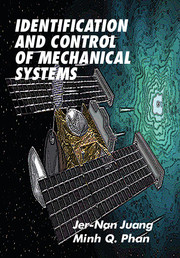Book contents
- Frontmatter
- Contents
- Preface
- 1 Ordinary Differential Equations
- 2 Elementary Matrix Algebra
- 3 Modeling Techniques
- 4 Finite-Element Method
- 5 Response of Dynamic Systems
- 6 Virtual Passive Controllers
- 7 State–Space Models
- 8 State-Feedback Control
- 9 Dynamic Feedback Controller
- 10 System Identification
- 11 Predictive Control
- Index
3 - Modeling Techniques
Published online by Cambridge University Press: 02 September 2009
- Frontmatter
- Contents
- Preface
- 1 Ordinary Differential Equations
- 2 Elementary Matrix Algebra
- 3 Modeling Techniques
- 4 Finite-Element Method
- 5 Response of Dynamic Systems
- 6 Virtual Passive Controllers
- 7 State–Space Models
- 8 State-Feedback Control
- 9 Dynamic Feedback Controller
- 10 System Identification
- 11 Predictive Control
- Index
Summary
Introduction
In this chapter, methods for developing dynamic equations of motion are introduced. We start with Newton's laws, which are fundamental to dynamic systems. Direct applications of Newton's laws to develop dynamic equations of motion become difficult for dynamic systems with complex configurations such as aircraft, automobiles, etc. D'Alembert's principle is introduced to derive the principle of virtual work for a body composed of a number of particles acted on by a number of external forces. By the concept of virtual work, Hamilton's principle is shown. Hamilton's principle is then used to formulate Lagrange's equation of motion (Refs. [1–2]). In contrast to Newton's second law, which involves vector quantities such as forces and accelerations, Hamilton's principle and Lagrange's equation use scalar quantities, including kinetic energy, potential energy, and virtual work, to develop the system's equations of motion. Along a similar line, Gibbs–Appell equations of motion are introduced with the scalar formed by the squared amplitude of acceleration instead of kinetic and potential energies. Finally, Kane's equations are derived with the same approach used in formulating the Gibbs–Appell equations. Kane's equations introduce a generalized speed vector rather than a scalar quantity (Ref. [3]). All techniques are related. Selecting a method to derive dynamic equations of motion is problem dependent.
Newton's Three Fundamental Laws
These laws were formulated and published by Sir Isaac Newton (1642–1726) in 1687 in his famous Principia (Philosophiae Naturalis Principia Mathematica).
- Type
- Chapter
- Information
- Identification and Control of Mechanical Systems , pp. 45 - 79Publisher: Cambridge University PressPrint publication year: 2001

